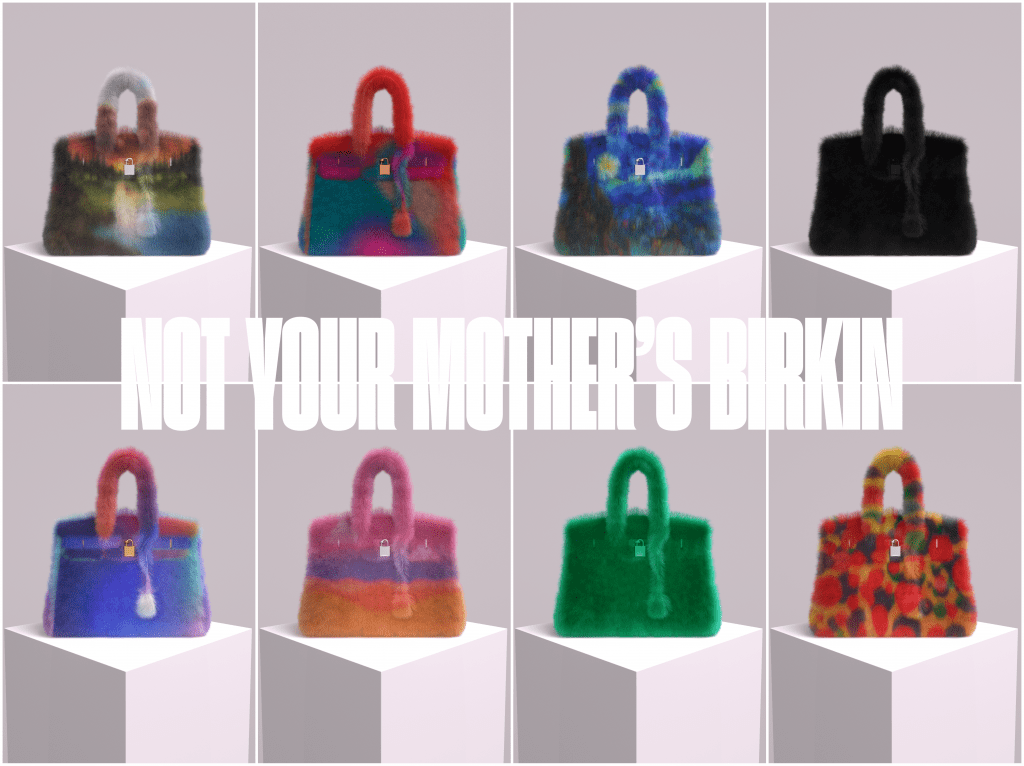A number of instances in the virtual space have prompted discussions about branding – and trademarks, more specifically. Most notably, Hermès called foul on a collection of 100 non-fungible tokens (“NFTs”) that tied to furry depictions of its famed Birkin bags last year and subsequently filed against the creator of the so-called MetaBirkins, Mason Rothschild, for trademark infringement, dilution, and cybersquatting in a New York federal court. Around the same time as Hermès first spoke out about the MetaBirkins, Darden Restaurants lodged an IP Takedown Request with NFT platform OpenSea to get NFTs linked to images of 880 physical outposts of its Olive Garden chain removed from the platform, with Darden arguing that the NFTs violate its trademarks and OpenSea’s anti-infringement terms.
The Hermès v. Rothschild case is the first major example of a brand taking action against the unauthorized use of its trademarks in the virtual world (the Miramax v. Tarantino case is based on copyright grounds but arguably shares some notable brand-specific elements with the Hermès case), and similar suits will inevitably follow as the “metaverse” – which stands to boast a budding valuation of $50 billion by Morgan Stanley’s estimates – continues to develop and draw in brands and unaffiliated actors, alike.
It is still early days for the metaverse, which currently consists of walled-gardens. However, it seems safe to say at this point that the Hermès case – and others like it – may be relatively straightforward in some respects. For example, the trademarks rights at the heart of these virtually-focused suits may not be drastically different from the ones that brands point to in cases over tangible goods. The rights and registrations that brands have amassed in connection with their core “real world” business activities – such as marketing and selling garments and accessories at retail, including by way of e-commerce – very well may extend to related endeavors in the metaverse. (It is worth noting that Hermès points to a handful of its existing registrations across twenty classes of goods/services in its complaint, none of which are metaverse-specific.)
At the same time, the critical inquiry in a trademark infringement scenario does not change simply because there are NFTs involved – it remains the same no matter the medium: whether consumers are likely to be confused about the source of the allegedly infringing goods/services or the trademark holder’s affiliation with or approval of the allegedly infringing goods/services.
Remedies in the “Real” World
One area where the “real” world and the virtual world could potentially diverge – and where interesting questions exist – is on the remedies front. (Jurisdiction will also prove to be an interesting topic to consider when it comes to the metaverse, and we will dive into that in a separate article soon.)
The case over the MetaBirkins NFTs may be complicated to some extent by the fact that the allegedly infringing goods are not physical handbags but images tied to blockchain-hosted digital tokens, and what purchasers have acquired is essentially a digital certificate of ownership that consists of code that points to the individual images of the faux-furry bags. Because of the immutable nature of blockchain, no matter the outcome of such a case, the NFTs exist (even if they are removed from platforms like OpenSea), and they cannot be destroyed without dismantling the blockchain on which they are hosted. This means that the best outcome for a brand may be to have the NFTs sent to a burn address, which still does not actually destroy them but renders them incapable of being transferred anymore.
(It is worth noting that even if trademark lawsuit-filing brands are able to succeed in having defendants’ infringing or diluting NFTs rendered non-transferable, that is not a perfect remedy. The reality, as indicated by the MetaBirkins scenario, is that copycat products will, in fact, pop up, thereby, resulting in a situation that mirrors the one in which brands are forced to play a game of whack-a-mole to fight tangible infringements/counterfeits.)
Relegating NFTs to a burn address “would destroy the economic value of the NFTs,” according to University of Kentucky Law professor Brian Frye, “but the actual token is still going to be written on the blockchain.”
Chances are, it may never actually come to that because – as Frye notes – Hermès (and presumably, any other similarly-situated brands that opt to wage NFT-centric suits in the future) may not necessarily have claims against the NFTs, themselves. Hermès is really “making claims over how the NFTs are marketed insofar as they are marketed in a way that uses an Hermès trademark in a trademark capacity.” (Trademark infringement, after all, depends on a defendant’s use of the mark as a mark.) As such, in the event that Hermès prevails on its infringement claims, a more appropriate remedy might come in the form an injunction against the future listing of the NFTs in a way that is infringing.
But even that might not get brands all the way, as use in a non-infringing way could potentially see the MetaBirkins NFTs listed as something like “MetaBirkins, which are not affiliated with Birkins or Hermès.” Since Hermès has specifically stated in its complaint that Rothschild’s inclusion of a disclaimer on the MetaBirkins website actually makes matters worse (as it “excessively uses the HERMÈS mark” and “unnecessarily links to Hermès’ website,” thereby creating “a confusing impression among consumers as to Hermès’ sponsorship of the MetaBirkins NFTs and the MetaBirkins website”), it is difficult to image that such a remedy would be viewed kindly by brands.
What Do Brands Stand to Gain?
With this and other, similar issues in mind, the potentially-precedent-setting scuffle between Hermès and Rothschild ultimately raises questions about what brands generally stand to gain in such cases, particularly given the outcomes in cases like Rogers v.Grimaldi, which established that the use of a trademark in an artistic work is actionable only if the use of the mark has no artistic relevance to the underlying work, or explicitly misleads as to the source or content of the work, and more recently, the Bad Spaniels case, in which the U.S. Court of Appeals for the Ninth Circuit expanded the scope of First Amendment protection to products like dog toys.
The answers to these questions are not necessarily crystal clear.
What does seem to be relatively apparent is that even if an array of factors (like the trademarks rights at play, the test for gauging infringement, etc.) remain the same no matter the medium, the MetaBirkins case and other brand v. NFT creator squabbles are forcing brands (and their lawyers) to consider a whole host of potentially novel questions, including how they want to approach unaffiliated uses of their marks in this burgeoning new space and what their likelihood of success is if they opt to pursue legal action, while also weighing the potential for pressure from within to enforce their often-very-famous marks.
While the rise of NFTs and unauthorized trademark uses within the metaverse do not create “any kind of existential problems for trademark law,” Frye says that they do “require brands and trademark practitioners, alike, to wrap their heads around what is taking place, and understand the nature of the claims they want to make and why they want to make them.” This includes thinking about “whether these are the types of uses that we are actually entitled to stop [under trademark law] in the first place,” particularly as “the way that people are doing art and speaking about the world is changing.”
In this vein, Frye claims that many brands “do not yet understand what is going on in the NFT space well enough to conceptualize what types of things they should be opposing, what they should be indifferent to and maybe even what they should be embracing.”
None of this is not made simpler by the fact that instances like the MetaBirkins and the Non-Fungible Olive Gardens NFTs “look like a weird mix of art and commerce” – or in words, “there is expressive use at play but [the creators] are also trading on the companies’ names.” Ultimately, Frye claims that these situations present some difficult questions, and “there may not be doctrinal answers,” potentially making the outcomes of these budding clashes “more of an issue of policy.”











